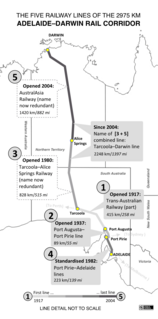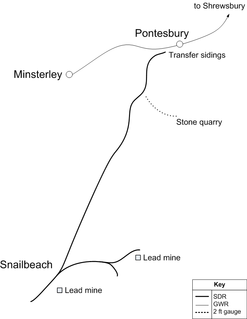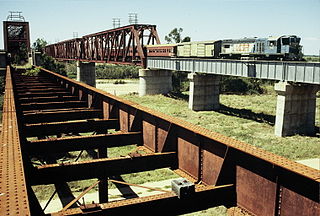Related Research Articles

The Shay locomotive was the most widely used geared steam locomotive. The locomotives were built to the patents of Ephraim Shay, who has been credited with the popularization of the concept of a geared steam locomotive. Although the design of Ephraim Shay's early locomotives differed from later ones, there is a clear line of development that joins all Shays.

The Adelaide–Darwin rail corridor is a 2,975 kilometres (1,849 mi) series of south–north transcontinental railway lines in Australia, between the cities of Adelaide and Darwin. Built in stages in the twentieth century, the corridor was completed in 2004 when the Alice Springs to Darwin line opened. The corridor is used by The Ghan passenger train and freight trains operated by One Rail Australia.

Snailbeach District Railways was a British narrow gauge railway in Shropshire. It was built to carry lead ore from mines in the Stiperstones to Pontesbury where the ore was transshipped to the Great Western Railway's Minsterley branch line. Coal from the Pontesford coal mines travelled in the opposite direction. The line ended at Snailbeach, the location of Shropshire's largest and richest lead mine, though there had been a plan to extend it further, which would have brought it closer to more lead mines.

Crofton is a small east coast town within the District of North Cowichan of southern Vancouver Island in British Columbia. This ferry terminal lies east of BC Highway 1 about 74 kilometres (46 mi) north of Victoria.

Henry Croft was an Australian-born lumber and mining magnate on Vancouver Island from the 1880s to 1900s. Born in Australia, Croft moved to England at a young age and was educated there. He moved to Canada in 1883 and became involved in logging, purchasing the sawmill in Chemainus. Croft rose in prominence through his running of the mill, and further enhanced his standing by marrying a daughter of Robert Dunsmuir, a prominent industrialist on Vancouver Island. Croft was elected to the British Columbia Legislature in 1886, representing Cowichan, serving until 1894. He later became involved in mining on Mount Sicker, and founded the town of Crofton, British Columbia in 1902 as a place to house the smelter for mining.

The Kaslo and Slocan Railway was a 3 ft narrow-gauge railway between Kaslo, Slocan, and the mining community of Sandon in the Kootenay region of British Columbia between 1895 and 1955 totalling about 53 km (33 mi) of track. It was operated originally by the Great Northern Railway and later by the Canadian Pacific Railway.

The Campbeltown and Machrihanish Light Railway was a 2 ft 3 in narrow gauge railway in Kintyre, Scotland, between Campbeltown and the coalmining village of Machrihanish. Only three other passenger-carrying lines in the UK operated on the same gauge, all of them in Wales - the Corris Railway, the short-lived Plynlimon and Hafan Tramway and the Talyllyn Railway.

Ecton is a hamlet in the Staffordshire Peak District. It is on the Manifold Way, an 8-mile (13 km) walk and cycle path that follows the line of the former Leek and Manifold Valley Light Railway. Population details as at the 2011 census can be found under Ilam.
Mount Sicker is a small mountain on Vancouver Island, British Columbia, Canada. It is near Crofton, Chemainus and Duncan. It was named for John J. Sicker, a homesteader in the area.
The Redruth and Chasewater Railway,, was an early mineral railway line in Cornwall, England, UK. It opened in 1825 and was built to convey the output from copper mines in the Gwennap area to wharves on Restronguet Creek around Devoran, and to bring in coal to fuel mine engines; later it carried timber for pit props and also house coal.

The Wee Georgie Wood Railway is a 2 ft narrow gauge tourist tramway running from Tullah, on a 1.9 km (1.2 mi) short track by the edge of Lake Rosebery in the West Coast Municipality of Tasmania.
The East Cornwall Mineral Railway was a 1,067 mm gauge railway line, opened in 1872 to connect mines and quarries in the Callington and Gunnislake areas in east Cornwall with shipping at Calstock on the River Tamar. The line included a rope-worked incline to descend to the quay at Calstock.

The Cyprus Government Railway was a 2 ft 6 in narrow gauge railway network that operated in Cyprus from October 1905 to December 1951. With a total length of 76 miles (122 km), there were 39 stations, stops and halts, the most prominent of which served Famagusta, Prastio Mesaoria, Angastina, Trachoni, Nicosia, Kokkinotrimithia, Morphou, Kalo Chorio and Evrychou. The CGR was closed down due to financial reasons. An extension of the railway which was built to serve the Cyprus Mines Corporation operated until 1974.

Silver City, Pinos Altos and Mogollon Railroad was a 2 ft narrow gauge railway serving copper mines along the Continental Divide in the mountains of southwestern New Mexico. The communities of Silver City and Pinos Altos developed as 19th century miners recovered easily extracted gold and silver from ore deposits of the area. Standard-gauge Santa Fe Railroad reached Silver City in 1886, and SC, PA&M was incorporated 24 August 1889 to build a railway north to Mogollon, New Mexico. Construction was limited to 5 miles (8.0 km) of grading until Wisconsin-based Comanche Mining and Smelting purchased the railroad and the Pinos Altos mining claims of George Hearst in 1903 after horse-drawn ore transport became uneconomical. The Silver City smelter burned shortly after purchase, but was rebuilt with three blast furnaces and a reverberatory furnace to handle 225 tons of ore per day. Two Shay locomotives were moved to Silver City in August 1905 from the Gilpin tramway of Gilpin County, Colorado. The railroad was built through iron and limestone mines on Chloride Flat west of Silver City. The limestone was used as a flux for smelting the copper ore.

The Buffalo and Susquehanna Railroad was a railroad company that formerly operated in western and north central Pennsylvania and western New York. It was created in 1893 by the merger and consolidation of several smaller logging railroads. It operated independently until 1929, when a majority of its capital stock was purchased by the Baltimore and Ohio Railroad. At the same time, the B&O also purchased control of the neighboring Buffalo, Rochester, and Pittsburgh Railway. The Baltimore and Ohio officially took over operations of both roads in 1932.

The Goldsworthy railway, owned and operated by BHP Billiton, is a private rail network in the Pilbara region of Western Australia built to carry iron ore. It is one of two railway lines the group operates in the Pilbara, the other being the Mount Newman railway.

The Glenariff Iron Ore and Harbour Company (GIOH) was a railway and harbour company in Glenariff, County Antrim, in what is now Northern Ireland. It operated Red Bay Pier on the Antrim coast and about 4 miles (6.4 km) of narrow gauge railway between the pier and Cloughcor Mines in Glenariff. The railway was 3 ft narrow gauge and carried iron ore from the mines to the pier, where it was loaded onto cargo ships for export to ironworks in Scotland and England.

The Great Northern Railway is a 1,067 mm railway line in Queensland, Australia. The line stretches nearly 1,000 kilometres linking the port city of Townsville, Australia to the mining town of Mount Isa in north-west Queensland. Along with a passenger service called the Inlander, it is a major freight route connecting the Mount Isa Mines to the Port of Townsville. In 2010 the line moved 5.8 million tonnes of cargo, and this is expected to increase significantly in coming years.

The United Verde and Pacific Railway was a 3 ft narrow gauge railroad that operated from 1895 to 1920 in what became Yavapai County in the U.S. state of Arizona. William A. Clark built the 26-mile (42 km) line to link his copper mine and smelter in Jerome to an existing branch of the Santa Fe Railway system. Clark eventually replaced the line with three 4 ft 8 1⁄2 instandard gauge rail lines after building a new smelter and company town in Clarkdale.

Devon Great Consols was a copper mine near Tavistock in Devon. The lease on the site was taken from the Duke of Bedford in 1844 by a group of investors. The 1,024 shares, sold at one pound each, were divided among the six men. Earlier attempts to mine this property had all ended in failure.
References
- White, Elwood; Wilkie, David (1968). Shays on the Switchbacks: A History of the Narrow Gauge Lenora, Mt. Sicker Railway. British Columbia Railway Historical Association.